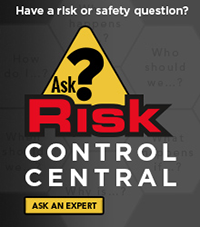Risk Reporter for Senior Living Communities
Spring 2016 Vol. 17, Issue 1
In this issue
Security measures for your senior living center cannot be ignored
Protection (public spaces)
Outdoor security 101: 5 upgrades every senior living center should consider
Protection (security teams)
Ramp up protection with security teams
Protection (security management)
Senior living center security management systems are evolving
Protection (buildings and grounds)
An ounce of prevention keeps buildings, grounds safe
Protection (checklist)
Perimeter Security Protection Checklist
In this issue
Security measures for your senior living center cannot be ignored
Some people believe their senior living center is a safe area free from violence, vandalism and trouble — and in most cases they are right. Violent acts, however, in or around senior living centers, can and do happen.
That’s why many senior living center managers are now taking a more active role in developing safety plans and adding security upgrades around their buildings and grounds.
This Risk Reporter will explain how you can increase security at your senior living center. Use the tips to protect your people, your property and yourself from becoming a victim of vandalism or random violence.
Did You Know?
PROPERTY PROTECTION TIP
For assistance with outdoor security planning, call our Risk Control Consulting and Research Center at (800) 554-2642, ext. 5213, or email riskconsulting@churchmutual.com.
Protection (public spaces)
Outdoor security 101: 5 upgrades every senior living center should consider
Here are five simple, but important, upgrades you can make to help ensure the safety of your staff, residents, visitors and volunteers.
- Consider your foliage. Keep all bushes around your buildings trimmed so people cannot hide behind them.
- Locks. Eliminate easy access into your buildings by locking all doors and windows when not in use, and any roof hatch access points. Have people enter and leave through one main entrance door that can be monitored. Require all visitors and vendors to check in at the main reception area.
- Keep track of your keys. Keep a record of who has keys and keycard access and review it regularly. Rekey your locks if a key is lost or not returned when there is a turnover in staff.
- Lighting. Keep interior lights on in the common areas throughout the night, for residents’ safety and to deter outside threats.
Also consider your facility’s outdoor lighting. It’s an essential part of adding security around your building and grounds. Ample lighting in the right places makes intruders less likely to choose your building. The parking lot and street entrances should also be well lit.
- Invite the community to get involved. If possible, start a Neighborhood Watch program within your local community. Neighbors look out for one another. Ask your local police or sheriff’s department about how to get started.
Did You Know?
PROPERTY PROTECTION RESOURCES
Church Mutual recommends our partner Insight Worldwide for pre-employment hiring assessments to help ensure the safety and security of your senior living communities. Log on to www.insightww.com or call 888-314-8908 for more information. Tell them you’re a Church Mutual customer to enjoy special discounts.
"In the common areas, the greatest lighting concern is often the aesthetic appearance of the fixture. However, in the apartments (in an independent living senior facility), it’s important to understand residents’ sight issues and to design and provide proper light levels to help elderly residents see better with less glare."
— Jay Massa
Kenall Manufacturing, which produces impact- and vandal-resistant lighting products, www.kenall.com
Protection (security teams)
Ramp up protection with security teams
It’s hard to miss reports of crime in the news these days. It seems no one is immune to violence, senior living centers included.
Creating a security team at your senior living center, however, can go a long way toward ensuring the safety of your staff, residents, visitors and volunteers.
Here are tips for creating your security team, putting a plan of action in place and setting standards for its operations.
- Put staff members and volunteers on your security team.
- Identify potential crisis events.
- Establish a written security and violence response plan for your organization.
- Train and use staff members and volunteers as a first line of defense to detect potential threats involving suspicious people, packages and vehicles.
- Establish procedures for patrolling exterior and interior areas before, during and after special events as well as during regular business hours.
- Conduct a security sweep of the entire building before locking all doors and windows for the day.
- Ask local neighborhood watch groups to help keep an eye on the property and report unusual activities to law enforcement.
- Conduct periodic safety surveys of all buildings and grounds and keep written records of conditions and corrective actions.
- Call police if a suspicious person is on your facility’s property and let the police investigate the situation.
- Establish a position on on-site armed protection.
If a potential thief knows he or she will be under surveillance, that person will likely think twice before targeting the establishment. This can mean the difference between your residents feeling safe or at risk.
Protection (security management)
Senior living center security management systems are evolving
The best way to protect your senior living center from crime is to put a security management system in place.
Many senior living centers have the typical combination of alarms, locks, gates and monitoring equipment.
But those aren’t always enough. Today you need to add proven security practices and procedures to complement your security strategy.
You should conduct a thorough security assessment of your buildings and grounds, for example.
Today, it’s fairly common for senior living centers to ask their local police departments to perform a security vulnerability assessment of the organization’s buildings and grounds.
Emergency personnel can show you where your property is most vulnerable. It’s a good idea to take photos of those areas so you can address the issues later.
You can create security teams, too.
Many senior living centers today are assembling in-house security teams. These teams are made up of staff members or volunteers who can help identify potential risks as they occur.
Often during a workshop, social activity or special event, staff members or volunteers will be the first to notice a problem. For that reason, senior living centers are encouraging them to join an in-house security team.
If you can, hire trained, professional security. Staff, residents, visitors and volunteers will immediately feel safer knowing there’s a guard on duty. Having security people walking your grounds also will help deter crime.
Another security trend at senior living centers today is the addition of 24/7 digital surveillance cameras. Having strategically placed cameras both indoors and out can be a powerful deterrent to vandals.
Did You Know?
PROPERTY PROTECTION TIP
The Nursing Home Reform Act stipulates that assisted living and senior facilities must provide or maintain the highest feasible level of care in regards to a patient’s physical, mental and social well-being, and a written plan must be put into action. Log on to www.assistedlivingfacilities.org/resources/safety/.
Protection (buildings and grounds)
An ounce of prevention keeps buildings, grounds safe
They say an ounce of prevention is worth a pound of cure. That’s especially true when it comes to security and protecting your senior living center. Not being prepared now could spell trouble later. To help avoid a potentially dangerous and costly situation, make sure you’re following these practices to harden your facility’s perimeter:
- Upgrade your outdoor lighting
Using the right size lamps and fixtures helps create a feeling of safety for staff, residents, visitors and volunteers. A good reference guide is the U.S. Department of Energy’s Exterior Lighting for Energy Savings, Security, and Safety. You can view it at http://tinyurl.com/zsrhwns.
Also consider replacing any incandescent lights with LED bulbs. LEDs are a little more expensive, but they last longer and typically are brighter.
- Install security cameras
Today’s digital cameras can connect wirelessly to a recording system in your main office or directly to your security provider. Install them near doorways and other high-traffic areas. Make sure your cameras are near a good light source so the images on your video are clear.
- Consider audible alarms
Many times, audible alarm systems are overlooked in favor of silent alarms. The sound of an alarm, however, is exactly what you need to signal an emergency. The sound also can alert the community to the potential danger.
- Install deadbolts
Deadbolts provide the best possible security of any door locks. You can get models that use letter combinations, passcodes or even your fingerprint to open doors.
- Consider an electronic keycard system
Many senior living centers today are replacing traditional key systems with keyless electronic cards. With a keyless system, you can:
- Manage a person’s access via computer
- Identify who used specific doors (and when)
- Deactivate a keycard when a staff member leaves
- Add safety curbs and barriers
If you think of your grounds as concentric circles, you want to be sure you have the right safety equipment in each area. In the outer circle, safety typically means controlling foot and automobile traffic.
Adding curbs around your grounds is a good way to direct the flow of traffic precisely where you want it to go. In addition, safety curbs or retaining walls offer excellent security benefits. Depending on the size of your barriers, you can use them to keep pedestrians from restricted areas too.
Terraces, raised plant beds, trees, planters, fencing, gatehouses and bollards also are good protective tools. Many senior living centers are using these types of alternatives to divert traffic, provide added security and beautify grounds.
Protection (checklist)
Perimeter Security Protection Checklist
PERIMETER SECURITY PROTECTION CHECKLIST
Name of facility:
Person conducting assessment:
Date:
Establish a neighborhood watch program.
( ) Satisfactory ( ) Needs Attention ( ) Not Applicable
Conduct periodic surveys to ensure exterior security lights are working and placed to illuminate building entrances, sidewalks, steps, loading docks and parking lots.
( ) Satisfactory ( ) Needs Attention ( ) Not Applicable
Trim overgrown trees and shrubs next to buildings to help eliminate hiding places.
( ) Satisfactory ( ) Needs Attention ( ) Not Applicable
Secure local law enforcement for daily/nightly patrols of parking lots and buildings.
( ) Satisfactory ( ) Needs Attention ( ) Not Applicable
Ask local law enforcement to conduct a free security vulnerability assessment of buildings and grounds to determine strengths and weaknesses of current security practices.
( ) Satisfactory ( ) Needs Attention ( ) Not Applicable
Put an access procedure in place for buildings that require people to enter and leave through a main, monitored entrance door.
( ) Satisfactory ( ) Needs Attention ( ) Not Applicable
Reprogram or rekey door locks after a key has been misplaced or not returned.
( ) Satisfactory ( ) Needs Attention ( ) Not Applicable
Conduct security walk-throughs regularly.
( ) Satisfactory ( ) Needs Attention ( ) Not Applicable
Regularly inspect efficacy of security alarms and/or video surveillance devices.
( ) Satisfactory ( ) Needs Attention ( ) Not Applicable
Conduct security team practice drills on potential crises situations.
( ) Satisfactory ( ) Needs Attention ( ) Not Applicable
Did You Know?
PROPERTY PROTECTION SOLUTIONS
To ensure you are doing all you can to protect your buildings and grounds, visit Church Mutual’s safety resources library at www.churchmutual.com/98/Safety-Resources. You’ll find checklists, videos, brochures and more.







